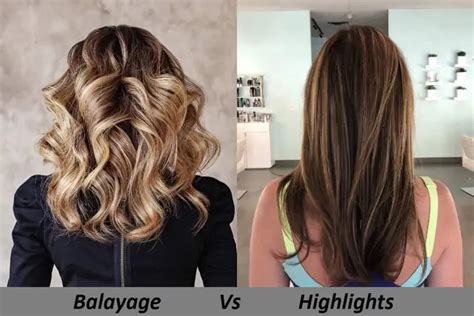Introduction
Hair coloring techniques have evolved over the years, offering a wide range of options for individuals to enhance their appearance and express their personality. Two popular methods that have gained immense popularity are balayage and highlights. Both techniques involve adding lighter tones to the hair, but they differ in their application, results, and suitability for different hair types and styles. This side-by-side comparison will help you understand the key differences between balayage and highlights, enabling you to make an informed decision about which technique is best suited for your needs.

Key Differences
| Feature | Balayage | Highlights |
|---|---|---|
| Application | Freehand painting | Foiling or cap highlighting |
| Result | Gradual, blended color | Defined, contrasting streaks |
| Effect | Natural, sun-kissed look | Bold, dimensional look |
| Low maintenance | Yes | No |
| Suitable for | All hair types | Fine hair |
Balayage
Balayage is a French hair coloring technique that translates to “to sweep.” It involves hand-painting lightener onto the hair in a freeform motion, creating a gradual and seamless blend of shades. The result is a natural, sun-kissed effect that mimics the way hair lightens naturally in the sun.
Advantages
- Natural and blended result
- Low maintenance, as the regrowth is less noticeable
- Suitable for all hair types
- Can be customized to create a variety of looks
Disadvantages
- Can be time-consuming
- Requires a skilled hair colorist
Highlights
Highlights are a hair coloring technique that involves separating sections of hair and applying lightener to them, resulting in defined, contrasting streaks. There are several methods for creating highlights, including foiling, cap highlighting, and comb highlighting.
Advantages
- Bold and dimensional look
- Can be placed strategically to frame the face or add volume
- Suitable for fine hair
- Can be used to correct color mistakes
Disadvantages
- High maintenance, as the regrowth is more noticeable
- Can damage hair if not done properly
- Not suitable for all hair types
Which Technique is Right for You?
The choice between balayage and highlights depends on your desired look, hair type, and lifestyle. If you prefer a natural, low-maintenance look, balayage is a great option. If you want bold, defined streaks, highlights are a better choice.
Frequently Asked Questions
1. Which technique is more expensive?
The cost of balayage and highlights varies depending on the length of your hair, the complexity of the desired look, and the skill of the hair colorist. In general, balayage tends to be more expensive than highlights due to the freehand application technique and the higher level of skill required.
2. How long do balayage and highlights last?
Balayage results can last for several months with proper care, as the regrowth is less noticeable. Highlights, on the other hand, require more frequent touch-ups as the regrowth is more visible.
3. Are balayage and highlights damaging to hair?
Both balayage and highlights involve the use of lightener, which can damage hair if not done properly. It is important to choose a skilled hair colorist who uses high-quality products and takes precautions to minimize damage.
4. Can I do balayage or highlights at home?
While there are DIY kits available, it is not recommended to attempt balayage or highlights at home. These techniques require a high level of skill and could result in uneven or unwanted results.
5. How often should I get balayage or highlights?
The frequency of touch-ups will depend on your desired look and hair growth rate. Balayage typically requires less frequent touch-ups than highlights.
6. What are the alternatives to balayage and highlights?
If you are looking for a low-maintenance alternative to balayage or highlights, consider ombré, which involves gradually blending two colors from light to dark. Another option is lowlights, which involve adding darker tones to the hair to create a more dimensional look.
7. How can I maintain balayage or highlights?
To prolong the results of balayage or highlights, use color-safe shampoos and conditioners, avoid excessive heat styling, and get regular trims to remove split ends.
Conclusion
Balayage and highlights offer distinct hair coloring techniques that can enhance your appearance and complement your personal style. By understanding the key differences between these two methods, you can make an informed decision about which technique is best suited for your hair type, desired look, and lifestyle. Whether you prefer a natural, blended effect or bold, defined streaks, there is a hair coloring technique that can help you achieve your desired look.
